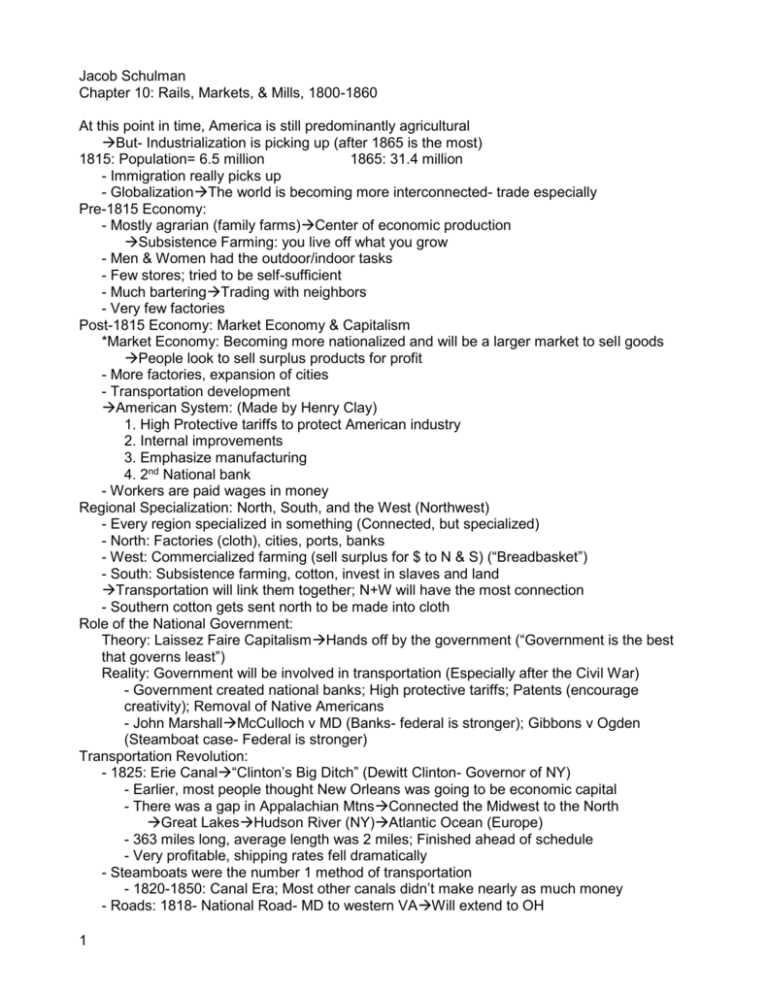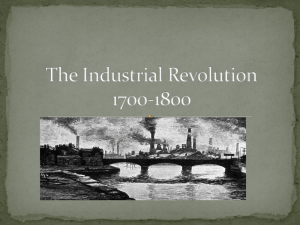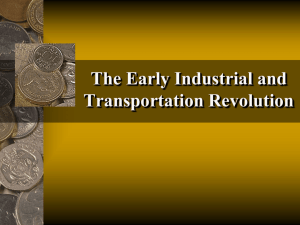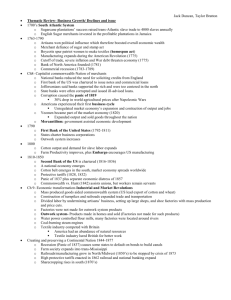Chapter 10 Typed Notes
advertisement

Jacob Schulman Chapter 10: Rails, Markets, & Mills, 1800-1860 At this point in time, America is still predominantly agricultural But- Industrialization is picking up (after 1865 is the most) 1815: Population= 6.5 million 1865: 31.4 million - Immigration really picks up - GlobalizationThe world is becoming more interconnected- trade especially Pre-1815 Economy: - Mostly agrarian (family farms)Center of economic production Subsistence Farming: you live off what you grow - Men & Women had the outdoor/indoor tasks - Few stores; tried to be self-sufficient - Much barteringTrading with neighbors - Very few factories Post-1815 Economy: Market Economy & Capitalism *Market Economy: Becoming more nationalized and will be a larger market to sell goods People look to sell surplus products for profit - More factories, expansion of cities - Transportation development American System: (Made by Henry Clay) 1. High Protective tariffs to protect American industry 2. Internal improvements 3. Emphasize manufacturing 4. 2nd National bank - Workers are paid wages in money Regional Specialization: North, South, and the West (Northwest) - Every region specialized in something (Connected, but specialized) - North: Factories (cloth), cities, ports, banks - West: Commercialized farming (sell surplus for $ to N & S) (“Breadbasket”) - South: Subsistence farming, cotton, invest in slaves and land Transportation will link them together; N+W will have the most connection - Southern cotton gets sent north to be made into cloth Role of the National Government: Theory: Laissez Faire CapitalismHands off by the government (“Government is the best that governs least”) Reality: Government will be involved in transportation (Especially after the Civil War) - Government created national banks; High protective tariffs; Patents (encourage creativity); Removal of Native Americans - John MarshallMcCulloch v MD (Banks- federal is stronger); Gibbons v Ogden (Steamboat case- Federal is stronger) Transportation Revolution: - 1825: Erie Canal“Clinton’s Big Ditch” (Dewitt Clinton- Governor of NY) - Earlier, most people thought New Orleans was going to be economic capital - There was a gap in Appalachian MtnsConnected the Midwest to the North Great LakesHudson River (NY)Atlantic Ocean (Europe) - 363 miles long, average length was 2 miles; Finished ahead of schedule - Very profitable, shipping rates fell dramatically - Steamboats were the number 1 method of transportation - 1820-1850: Canal Era; Most other canals didn’t make nearly as much money - Roads: 1818- National Road- MD to western VAWill extend to OH 1 - Bridge: Charles River Bridge v Warren BridgeSupreme court says that they want to encourage competition to avoid monopolies - Railroads: Only became very popular close to the Civil War 1830: 30 miles 1850: 9k miles 1860: 31k miles - B&O Railroad – Baltimore & Ohio Railroad=1st railroad - Early on, there was no real standardization of track width - Railroad engines had trouble with sharp turns and steep inclines ManufacturingIndustrial Revolution Part I (1820-1860) - Replacement of hands by machines Small Workshops Large Factories - Production increases, prices drop - Lowell SystemAll manufacturing is combined in 1 place; Replaces Putting Out system - Helps with manufacturing efficiency - Samuel Slater (British Inventor)Came to America and made the first factory - First industry was textiles Eli Whitney: Cotton Gin & Interchangeable Parts (Standardization of Machine parts) - Conditions: Poor air quality, sunrise to sundown; “Wage Slavery” 2








